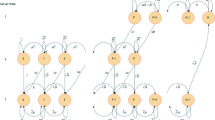Abstract
In this paper, we consider several discrete-time priority queues with priority jumps. In a priority scheduling scheme with priority jumps, real-time and non-real-time packets arrive in separate queues, i.e., the high- and low-priority queue respectively. In order to deal with possibly excessive delays however, non-real-time packets in the low-priority queue can in the course of time jump to the high-priority queue. These packets are then treated in the high-priority queue as if they were real-time packets. Many criteria can be used to decide when packets of the low-priority queue jump to the high-priority queue. Some criteria have already been introduced in the literature, and we first overview this literature. Secondly, we propose and analyse a new priority scheme with priority jumps. Finally, we extensively compare all cited schemes. The schemes all differ in their jumping mechanism, based on a certain jumping criterion, and thus all have a different performance. We show the pros and cons of each jumping scheme.
Similar content being viewed by others
References
Bae, J. J., & Suda, T. (1994). Survey of traffic control schemes and protocols in ATM networks. ACM Transactions on Networking, 2(5), 508–519.
Jang, J. S., Schim, S. H., & Shin, B. C. (1997). Analysis of DQLT scheduling policy for an ATM multiplexer. IEEE Communications Letters, 1(6), 175–177.
Lee, Y., & Choi, B. D. (2001). Queueing system with multiple delay and loss priorities for ATM networks. Information Sciences, 138(1–4), 7–29.
Lim, Y., & Kobza, J. E. (1990). Analysis of a delay-dependent priority discipline in an integrated multiclass traffic fast packet switch. IEEE Transactions on Communications, 38(5), 659–685.
Maertens, T., Walraevens, J., & Bruneel, H. (2006a). On priority queues with priority jumps. Performance Evaluation, 63(12), 1235–1252.
Maertens, T., Walraevens, J., Moeneclaey, M., & Bruneel, H. (2006b). A new dynamic priority scheme: performance analysis. In Proceedings of the 13th international conference on analytical and stochastic modelling techniques and applications (ASMTA2006), pp. 74–84.
Maertens, T., Walraevens, J., & Bruneel, H. (2007). A modified HOL priority scheduling discipline: performance analysis. European Journal of Operational Research, 180(3), 1168–1185.
Walraevens, J., Steyaert, B., & Bruneel, H. (2003). Performance analysis of a single-server ATM queue with a priority scheduling. Computers and Operations Research, 30(12), 1807–1829.
Author information
Authors and Affiliations
Corresponding author
Rights and permissions
About this article
Cite this article
Maertens, T., Walraevens, J. & Bruneel, H. Performance comparison of several priority schemes with priority jumps. Ann Oper Res 162, 109–125 (2008). https://doi.org/10.1007/s10479-008-0314-5
Received:
Accepted:
Published:
Issue Date:
DOI: https://doi.org/10.1007/s10479-008-0314-5




